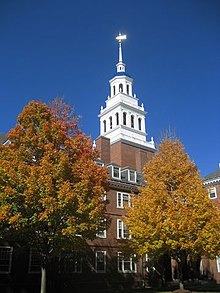
Harvard College is the undergraduate college of Harvard University, a private Ivy League research university in Cambridge, Massachusetts, United States. Part of the Faculty of Arts and Sciences, Harvard College is Harvard University's traditional undergraduate program, offering AB and SB degrees. It is highly selective, with fewer than four percent of applicants being offered admission as of 2022.
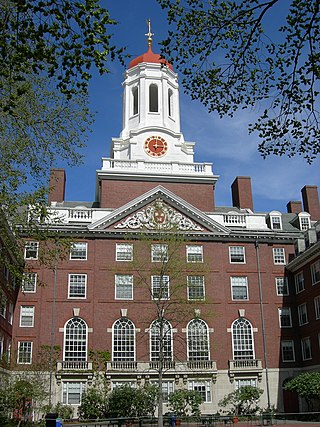
Dunster House is one of twelve undergraduate residential houses at Harvard University. Built in 1930, it is one of the first two dormitories at Harvard University constructed under President Abbott Lawrence Lowell's House Plan and one of the seven Houses given to Harvard by Edward Harkness. In the early days, room rents varied based on the floor and the size of the room. Dunster was unique among Harvard dormitories for its sixth-story walk-up ; these rooms were originally rented by poorer students, such as Norman Mailer.

Branford College is one of the 14 residential colleges at Yale University.

The Kenneth C. Griffin Graduate School of Arts and Sciences (GSAS) is the largest of the twelve graduate schools of Harvard University, when measured by the number of degree-seeking students. Formed in 1872, GSAS is responsible for most of Harvard's graduate degree programs in the humanities, social sciences, and natural sciences. The school offers Master of Arts (AM), Master of Science (SM), and Doctor of Philosophy (PhD) degrees in approximately 58 disciplines.
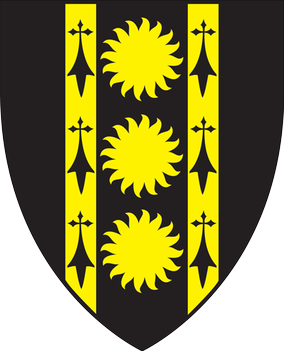
Pierson College is a residential college at Yale University in New Haven, Connecticut. Opened in 1933, it is named for Abraham Pierson, a founder and the first rector of the Collegiate School, the college later known as Yale. With just under 500 undergraduate members, Pierson is the largest of Yale's residential colleges by number of students.

Jonathan Edwards College is a residential college at Yale University. It is named for theologian and minister Jonathan Edwards, a 1720 graduate of Yale College. JE's residential quadrangle was the first to be completed in Yale's residential college system, and was opened to undergraduates in 1933.

Pforzheimer House, nicknamed Pfoho (FOE-hoe) and formerly named North House, is one of twelve undergraduate residential Houses at Harvard University. It was named in 1995 for Carol K. and Carl Howard Pforzheimer Jr, major University and Radcliffe College benefactors, and their family.

Mather House is one of twelve undergraduate residential Houses at Harvard University. Opened in 1970, it is named after Increase Mather, a Puritan in the Massachusetts Bay Colony who served as President of Harvard University from 1681 to 1701. Mather's Faculty Deans are Lakshminarayanan Mahadevan and Amala Mahadevan.
In each of the twelve Houses in the Harvard College House system, the Allston Burr Resident Dean is an Assistant Dean of the College, responsible for the academic and disciplinary well-being of the undergraduates in that House. The House's highest official other than the Faculty Dean, the Allston Burr Resident Dean has primary supervision of the House tutors. The Resident Dean assists the Faculty Dean in selecting House tutors. The Resident Deans report to the Dean of the College and sit on the Administrative Board, the College disciplinary body.

Danilov Monastery is a walled monastery on the right bank of the Moskva River in Moscow. Since 1983, it has functioned as the headquarters of the Russian Orthodox church and the official residence of the Patriarch of Moscow and all Rus'.
Leverett House is one of twelve undergraduate residential Houses at Harvard University. It is situated along the north bank of the Charles River in Cambridge and consists of McKinlock Hall, constructed in 1925; two 12-story towers completed in 1960; and two floors of 20 DeWolfe Street, a building Leverett shares with two other houses at Harvard.

John Winthrop House, commonly known as Winthrop House, is one of 12 undergraduate residential Houses at Harvard University, an Ivy League university in Cambridge, Massachusetts, which houses approximately 400 upper class undergraduates.
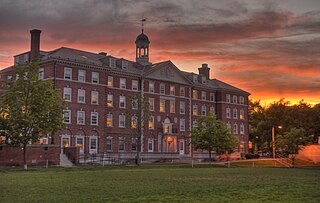
Cabot House is one of twelve undergraduate residential Houses at Harvard University. Cabot House derives from the merger in 1970 of Radcliffe College's South and East House, which took the name South House, until the name was changed and the House reincorporated in 1984 to honor Harvard benefactors Thomas Cabot and Virginia Cabot. The house is composed of six buildings surrounding Radcliffe Quadrangle; in order of construction, they are Bertram Hall (1901), Eliot Hall (1906), Whitman Hall (1911), Barnard Hall (1912), Briggs Hall (1923), and Cabot Hall (1937). All six of these structures were originally women-only Radcliffe College dormitories until they were integrated in 1970. Along with Currier House and Pforzheimer House, Cabot is part of the Radcliffe Quad.
Currier House is one of twelve undergraduate residential Houses of Harvard College, in Cambridge, Massachusetts, United States. Opened in September 1970, it is named after Audrey Bruce Currier, a member of the Radcliffe College Class of 1956 who, along with her husband, was killed in a plane crash in 1967. The area was formerly used as housing for Radcliffe College, and as such the four towers of Currier House are named for distinguished alumnae of Radcliffe, including the author Barbara Tuchman. Along with Cabot House and Pforzheimer House, Currier is part of the former Radcliffe Quadrangle, known colloquially as simply "the Quad."

At the Massachusetts Institute of Technology (MIT), students are housed in eleven undergraduate dorms and nine graduate dorms. All undergraduate students are required to live in an MIT residence during their first year of study. Undergraduate dorms are usually divided into suites or floors, and usually have Graduate Resident Assistants (GRA), graduate students living among the undergraduates who help support student morale and social activities. Many MIT undergraduate dorms are known for their distinctive student cultures and traditions.

Deans Court is a student hall of residence at the University of St Andrews originating from the 12th century, thus, arguably, the oldest dwelling house in the town of St Andrews, Scotland. It stands at the east-end of St Andrews, where North street and South street converge. The entrance of the courtyard opens up to the ancient, ruined, St Andrews cathedral. The Hall is open exclusively to postgraduates, and comprises the main building and four annexes, two on North Street, two on South Street. Current residents are affectionately known as Deans Courtiers, Deans Courtesans, or Deans Beans.
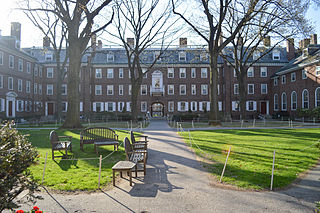
Kirkland House is one of twelve undergraduate residential Houses at Harvard University, located near the Charles River in Cambridge, Massachusetts. It was named after John Thornton Kirkland, president of Harvard University from 1810 to 1828.

Quincy House is one of twelve undergraduate residential Houses at Harvard University, located on Plympton Street between Harvard Yard and the Charles River. The second largest of the twelve undergraduate houses, Quincy House was named after Josiah Quincy III (1772–1864), president of Harvard from 1829 to 1845. Quincy House's official counterpart at Yale University is Branford College.
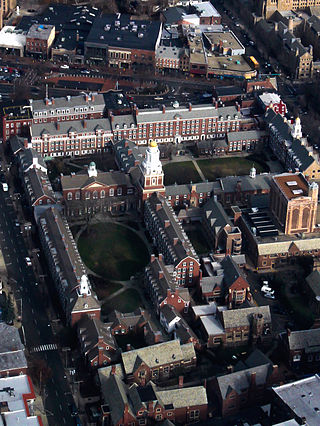
Yale University has a system of fourteen residential colleges with which all Yale undergraduate students and many faculty are affiliated. Inaugurated in 1933, the college system is considered the defining feature of undergraduate life at Yale College, and the residential colleges serve as the residence halls and social hubs for most undergraduates. Construction and programming for eight of the original ten colleges were funded by educational philanthropist Edward S. Harkness. Yale was, along with Harvard, one of the first universities in the United States to establish a residential college system.

The Baker Library/Bloomberg Center is a building complex at Harvard Business School on the campus of Harvard University in the Allston neighborhood of Boston, Massachusetts, United States. It includes the Baker Library, built in 1927, and the Bloomberg Center, completed in 2005.

